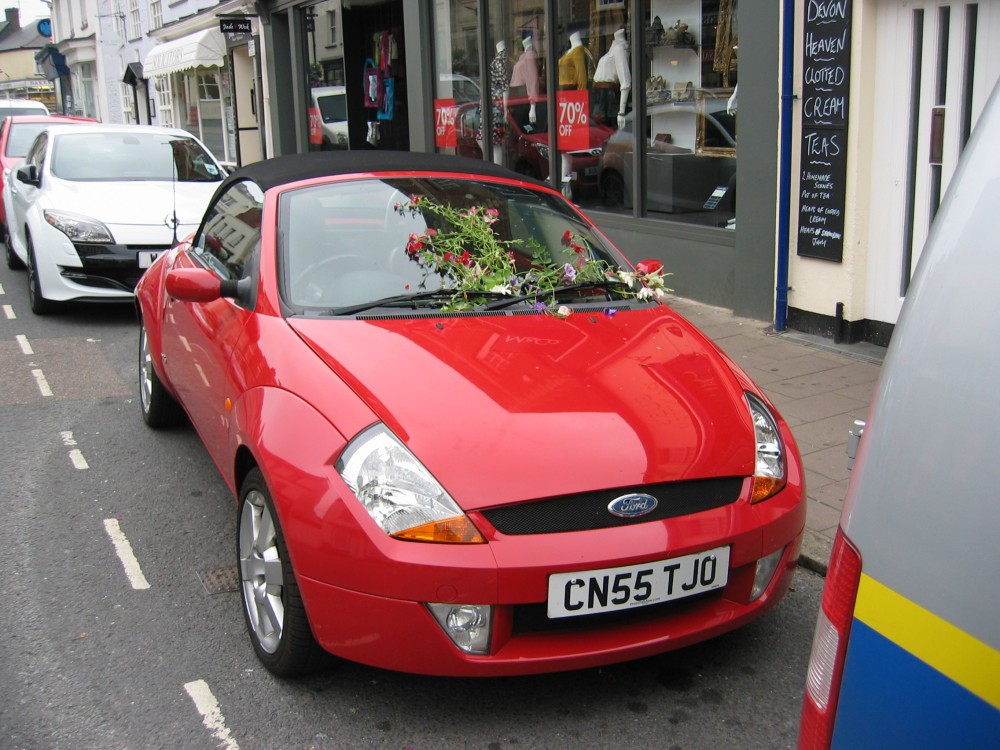Sidmouth FolkWeek 2011 - How
Sidmouth FolkWeek could help revive folk dancing.
 |
Sidmouth High Street and a particularly cute
little car. I couldn't find anywhere else to put this photo - but it had to go
somewhere!
Early Tuesday morning and overnight revellers seem to have ripped Britain in Bloom
flowers from nearby displays.
The car may have been parked here all night.
Maybe someone is in love with the owner?
But the flowers were later discarded onto the road. |
Social folk dance and to some extent
ceilidh dance has been in decline in the UK for years. Some folk dance clubs have closed,
others are closing. Some estimates of the small numbers of people
involved are available: the number of highly accomplished dancers in the UK is
probably less than 1000.
One critical factor in reversing the
decline will be the degree of good quality teaching and practice available. Another will
be simply making people aware of the types of dance that are a part of English history -
some social and ceilidh dances can be traced back hundreds of years. Despite the potential
for these forms of dance, the only dances often on display at folk festivals (and
including Sidmouth) are Morris and highly difficult step dance routines - some which do
not originate in the UK. Whilst these can all be admired, few people might ever be tempted
to try and learn them!
The emphasis of Morris dance is on costumes
and noise - the dances are often simple. In contrast, social and ceilidh dances - which
anyone could learn given the opportunity and some encouragement - are rarely part of
public displays. They are more than usually hidden away either in church or village halls
or in dance marquees.
A notable 'first' at the Chippenham Folk
Festival in May 2011 was a short public display of social dance - a few experienced
dancers learnt quite a complicated dance from Rhodri Davies and performed it as a display
later the same day. Most of us got it right! The emphasis was on 'look what experienced
dancers can learn in an hour or so' rather than on what most of the audience could learn
in a few short lessons if they were given the opportunity.
Sidmouth Folk Festival used to include a
few opportunities for learning to dance - the late Mick Brookes taught classes but it was
never a central feature of the dance program, more just a few sparsely attended events
tacked onto the beginning of the week.
Sidmouth and Whitby are the only two
week-long major folk dance festivals in the UK - the rest are 'long weekend' affairs. Both
therefore offer the potential for taking non-dancers (casual on-lookers) and turning them
into quite confident and practised dancers at the end of the week - skilled enough to hold
their own at any local clubs when they returned home. But there are no mechanisms in place
for this to happen.
The requirements include:
1. social and ceilidh dance displays should
have as much public prominence as Morris dance - and with the marketing aimed at ''you can
do this too, there are classes this week to help you'.
2. experienced dancers need to be available
to help newcomers - it is unhelpful to expect people to learn with inexperienced partners.
3. the week needs to feature a series of
teaching sessions where there is slow, structured learning of all the basic moves, and
especially those that so many dancers have never mastered - such as swinging - and
which can be uncomfortable for partners if not done correctly.
4. the best of the 'never have danced
before' attendees should be able to put on a short display of a simple dance during one of
the events on the last day - to show how much people can learn in a few short lessons with
good instruction. It is done for the festival choir and for some children's events - so
why not for adult social dancing?
next page
back to top of section
back to home page
